Diamond Grading Labs: Different Strokes for Different Folks
July 13, 08
By Ken Gassman
IDEX Online Research sampled just under 12 million diamonds – 16 million carats worth of diamonds, roughly 3.5 tons, enough to fill the back of a small dump truck – to see if there were any relationships between the diamonds, the certificates that accompanied those diamonds and the labs that issued those certificates. We sliced and diced those 12 million diamonds by several factors, including the labs that certified the diamonds, the color of the diamonds, the cut, the clarity, the make and the size (weight) of the diamonds.
Research methodology – a huge sample
Our analysis was extracted from the IDEX Online diamond trading network. The IDEX Online diamond database includes the inventories of industry players that account for approximately 80 percent of the global diamond trade (by $ value); that’s by far a large enough sample from which to draw conclusions. Further, our sample of just under 12 million diamonds covered more than 100 individual days of trading. The value of the diamonds in our sample was just over $100 billion; that’s five times the annual polished diamond sales for the global diamond industry. Each day’s diamond sample was independent of every other day. This means that diamonds that remained for sale over a multi-day period were counted multiple times. Our methodology took that into account. In other cases, we could see that diamonds were put up for sale, apparently sold and that those same diamonds were later brought back into the market for sale again. With a sample of about 12 million diamonds, however, all those little trading idiosyncrasies tend to smooth out and become meaningless. Here are some broad conclusions from the data that we analyzed:
- Most polished diamonds posted online come with lab certificates. Almost 80 percent (by $ value) of all polished diamonds come with a certificate issued by a diamond grading lab. It appears that the number of certified diamonds continues to increase. Diamond certificates help authenticate a diamond’s characteristics for quality and pricing purposes.
- A certified diamond is very important in the consumer market. A certified diamond helps boost confidence in a product of which shoppers have little technical knowledge. When consumers buy a diamond without a certificate, it is a little like buying a used car without a warranty: caveat emptor.
- The GIA lab owns the market for diamond certs. Among all polished diamonds, roughly two-thirds have a GIA certificate.
- GIA certificates are issued for almost all grades, clarities, sizes, cuts and makes of stones. It was the only lab that seemed to grade just about any diamond in the market. GIA certificates were notably absent in two diamond categories: ideal cut stones and SI3 make stones.
- Some labs have specialties that are reflected in the certs that they issue. As one would expect, the AGS lab issues 70 percent of the certs that accompany ideal cut diamonds. The EGL USA lab seems to specialize in grading pear and marquise cut diamonds, while the HRD lab appears to specialize in grading emerald cut diamonds. Other labs appear to specialize in grading lower quality gemstones.
- Diamond certificates issued by some labs seem to have a higher value than others. For example, diamonds with a certificate issued by either the AGS lab or the GIA lab consistently fetch an above-average price per carat. On average, diamonds with either an AGS or a GIA cert carry a consistently higher price premium – 14-21 percent – over the average price for any given diamond.
- AGS price premiums tend to cluster around the mean; GIA price premiums show greater variation. In other words, AGS price premiums tend to be in the high-teen, low-20 percent range, while GIA price premiums show greater variation – as much as 10 points below or above the mean. On average, however, price premiums from both labs average about the same.
- An HRD certified diamond also tends to fetch an above-average per-carat price, though not quite as high as either AGS or GIA. HRD certified diamonds tend to show a price premium in the 8-14 percent range. However, very few diamonds – just over 1 percent – come with an HRD certificate.
- The AGS lab tends to grade only better quality stones. While the AGS lab grades less than 2 percent of all diamonds, those diamonds tend to be better quality stones in terms of color, make and clarity.
- When a diamond’s make (cut grade) is not considered, per-carat prices of diamonds vary widely. Prices of diamonds with identical 4 Cs – cut, carat, color, and clarity – ranged from 30-35 percent above the median per-carat price to 30-35 percent below the median price. Among diamonds of the same cut, color, carat and clarity, the highest per-carat price was often double the price of diamonds with the lowest per-carat price, when make is not considered.
- When make (cut grade) is included as a factor affecting price, the per-carat prices of diamonds of the same cut, carat, color and clarity vary less. They range from about 20 percent above the median per-carat price to about 20 percent below the median price. In other words, a diamond’s make is a very important factor in determining the price of that diamond.
What our research did not uncover
Our research did not discuss why there is so much variation among diamond labs and the certificates they issue. For sure, diamond grading is a qualitative process, relying on people’s opinions about color, clarity and other factors. Machines have been invented that are supposed to take the human factor out of the grading process, but most labs rely on highly skilled diamond graders – people – to review each diamond and issue an opinion. Industry participants also acknowledge that some diamond grading labs are more lenient than others. We found evidence of that, but it is beyond the scope of this research. Besides, we don’t engage in mud-slinging, because it could hurt a particular lab. We simply let the numbers tell the story.
The Polished Diamond Market: A Nearly Perfect Bell Curve
Among the 12 million diamonds included in our research project, Idex Online research found that the market operates just like any other capitalistic enterprise: demand and trading volume at either end of the market was low, while the center of the market was vibrant, liquid and high-volume.
Diamond trading patterns, when analyzed, tend to generate a nearly perfect bell curve. Here’s what this means to the industry: despite sometimes volatile day-to-day trading characteristics, industry trading patterns for diamonds – based on any of the five characteristics we analyzed – are highly predictable. Here are some of the key characteristics of the polished diamond trading market.
Color: whiter colors are high volume
When polished diamonds are segmented by color, the result is nearly a perfect bell curve, as graph 1 illustrates.
 |
The heart of the trading market – and the consumer market – is in the E, F, G and H colors. These colors represent two-thirds of the market for polished diamonds. Diamonds in the M through P color range represent 1 percent of the certified market.
Clarity: consumers are willing to put up with some flaws
An analysis of diamonds by clarity yields another nearly perfect bell curve. Diamond volume for internally flawless (IF) diamonds is low, as is volume for highly flawed diamonds. Graph 2 illustrates diamond volume by clarity.
 |
Trading volume in truly flawless (FL) diamonds is so low that we could not generate a meaningful analysis for our research study. sIze: the market Is concentrated
In the 0.5 to 2 carat range.
About three-fourths of all polished diamond volume occurs in stones ranging from 0.5 carats to 2 carats in size. Again, market volume and demand follows a bell curve, as graph 3 illustrates.
 |
Cut: It’s a round stone market
The round cut diamond is overwhelmingly the most popular diamond. Volume and demand for round diamonds is more than three times as great as the volume and demand for the second most popular diamond cut – the princess cut. Graph 4 illustrates the market for the most popular diamond cuts.
|
|
Table 1 illustrates market demand and volume for all of the diamond cuts included in our research survey. If you’ve never heard of some of the more obscure diamond cuts, don’t feel alone: we are also unfamiliar with some of them.
 |
Make (cut grade): a surprise – “no make” wins
Most diamantaires put some significant emphasis on a diamond’s make (cut grade), when they are trading it. Obviously, the better the make, the higher the price. But just under half (43 percent) of all diamonds traded do not have the make noted on the certificate (or come with no certificate). In our price analysis, a diamond’s make is a very important factor. Diamonds with a better make consistently fetched a much higher price than diamonds with no make. Graph 5 summarizes the volume and demand for diamonds by make. Again, the bars reflect a nearly perfect bell curve, when diamonds with “no make” is excluded.
 |
The most popular diamond
Based on diamond demand and volume, the most popular diamond in the market is a 1 carat, round, G color, VS2 clarity diamond with no make specified. There is a two-in-three chance that this diamond has a GIA certificate to authenticate those specifications.
Top Six Diamond Grading Labs Have 78 Percent Market Share
Some of the labs in our sample are well-known: GIA, AGS, HRD, EGL International, EGL USA and IGI. These six labs graded 78 percent of the diamonds in our sample; if diamonds with no certificates are excluded, these six labs grade 99.7 percent of all certified diamonds.
The remaining diamond grading labs serve regional customers and are less well-known in the global diamond market. A few grade diamonds for specific customers – their diamonds often do not trade on the global diamond bourses.
Of the 15 labs, only six have a market share of 1 percent or more – that is, they graded at least 120,000 diamonds (1 percent of 12 million). The other nine grading labs all together have only about two-tenths of one percent of the market (about 0.3 percent, if diamonds with no certificates are excluded from the calculation).
We basically ignored the results from those nine small labs, since we did not feel that we could draw statistically significant conclusions from their certificates. We did note, however, some broad trends, which we mentioned earlier. Mostly, these labs have specific niches in the diamond market – for example, they may grade diamonds in colors J through P, or they may grade SI3 or I3 diamonds. This is not to disparage their work; there may be other niches where they fill a specific market need.
Graph 6 summarizes the market share of the major diamond grading labs.
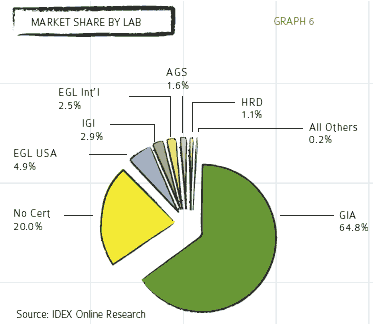 |
The Labs: Grading Analysis By Size Of Diamond
Our analysis of diamonds by size Included stones ranging from 0.5 carat to 9 carats. We broke these into “natural” groups, based on market trading and convention.
For the purposes of our research, we did not do an in-depth analysis of diamonds smaller than 0.5 carat. Diamonds under 0.5 carat represented only about 12 percent of our sample. Many of these diamonds are not certified, since it would be prohibitively expensive to pay for a certificate that could cost up to almost as much as the value of the diamond.
Lab certificates by size
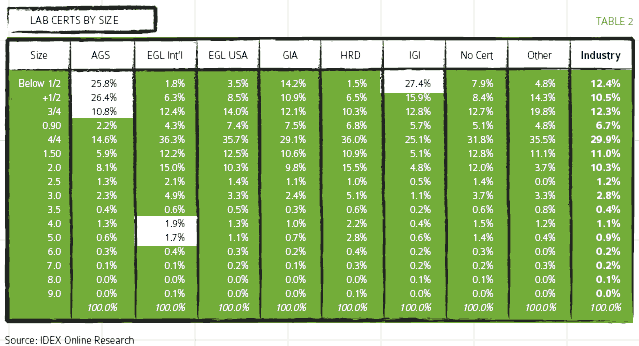 |
Table 2 illustrates diamond lab certificates by size. It analyzes a particular lab’s certificates by size. It should be read downward. For example, 25.8 percent of all AGS diamond certificates are issued for diamonds below 0.5 carat. That’s double the industry average that indicates 12.4 percent of all diamonds are below 0.5 carat in size. This table illustrates the specialty of each lab – what diamonds they focus on and what they do best. Here are some of our findings (highlighted in white) from the table below. Your analysis of the table may yield some specific findings related to your business. ∙
- More than 60 percent of all diamonds the AGS lab certifies are three-fourths of a carat and smaller in size.
- The EGL International lab grades a disproportionate number of diamonds in the 4-5 carat range.
- The IGI lab grades a large number of stones 1 carat and smaller.
Market share of each lab by size
 |
- AGS has significant market share in diamonds sized 0.5 carat and below.
- EGL International has significant market share in diamonds 2.5-6 carats in size.
- HRD tends to have greater market share in diamonds in the 3-7 carat size.
- IGI has disproportionate market share in diamond sizes 0.5 carat and below.
- GIA tends to grade a disproportionate number of smaller diamonds. For diamonds under 0.5 carat, GIA has almost three-fourths of the market. For larger diamonds 3 carat and above, it has only about half of the market share.
The Labs: Grading Analysis By Cut (Shape) OF Diamond
The cut of a diamond is a very important characteristic for consumers. Just over half of all diamonds are round cut. Our analysis of nearly 12 million diamonds found 33 different cuts. Of those, ten had a market share above 1 percent, while another four had measurable market share. The sample size of the balance of those 33 cuts was deemed to be too small for a statistically significant analysis.
Lab certificates by cut
Table 4 illustrates the mix of cuts graded by a particular lab. It should be read downward. For example, 95.3 percent of the certificates that AGS issues are for round diamonds. That’s understandable, since an ideal cut diamond is round, and AGS is known for its triple-zero grading of ideal cut diamonds.
Almost all of the diamonds that the AGS lab grades are round.
 |
- EGL International grades a large number of diamond cuts that are unusual (labeled “other” at the bottom of the left-hand column – 5.2 percent).
- EGL USA grades far fewer round diamonds than might be expected. Instead, it grades a disproportionate number of other cuts including radiant, pear, marquise and “other.”
- The HRD lab grades a large number of emerald cut diamonds.
- The smaller labs (labeled “other” across the top) seem to grade a disproportionate number of princess cut diamonds as well as “other” cuts (8.4 percent).
Market share of each lab by cut
 |
Some labs are known for grading diamonds in a particular niche. Table 4 hints at those niches, but table 5 helps pinpoint them even more closely. This table should be read across. For example, GIA grades 66.6 percent of all round stones versus HRD which grades 1.3 percent of all round stones.
- EGL International and EGL USA grade a disproportionate share of “other” (bottom cut in left hand column) diamond cuts. This appears to be a specialty niche for these two labs.
- EGL USA also grades a large number of pear and marquise cut diamonds.
- GIA grades a disproportionate number of Asscher cut diamonds.
- HRD grades a large number of emerald cut diamonds.
- Three diamond cuts – oval, marquise and “other” – are likely to be in the market without a certificate.
The Labs: Grading Analysis By Color Of Diamond
A diamond's color is very important to consumers, even if they really can’t see the difference between an f and g color, especially when the diamond ring is on their finger in a yellow gold mount.
But that’s not the point: consumers think they want the whitest diamond possible, so diamonds are graded by color, beginning with D color (called “colorless”) and ending at Z color. Our diamond sample did not contain any diamonds above P color. For research purposes, we analyzed all colors from D to P, but realistically we could have stopped at L or M, with virtually no change in results. Grading of a diamond for color remains a qualitative skill. Sure, there are machines that supposedly do the job, but the reality is that the best color grading is done by highly skilled technicians who measure a diamond’s color against a standard set of stones of various colors. Those technicians take frequent breaks from their work – every half-hour or so – and the labs are very careful about lighting and other factors that might affect the color grading process.
Lab certificates by color
Table 6 summarizes the mix of diamonds by color that a particular lab grades. It should be read downward. For example, 22.1 percent of the certificates that the AGS lab issues are for G color diamonds.
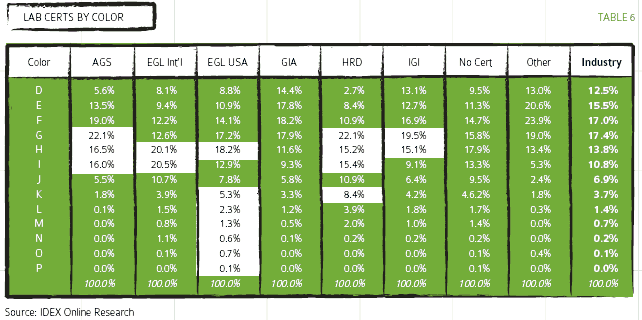 |
- The AGS lab issues certificates for a large number of stones G, H and I color.The EGL International lab focuses on diamonds in the H and I color range.The EGL USA lab seems to issue a large number of certificates for diamonds colored H and K through P. These lower colored diamonds seem to be a niche market for EGL USA.The HRD lab issues a number of certificates for diamonds colored G, H, I and K.IGI issues a number of diamond certificates for stones colored G and H.
Market share of each lab by color
Table 7 summarizes market share of each lab by color for diamonds. It should be read across. For example, EGL USA grades 3.4 percent of all D color stones, while GIA grades 74.2 percent of all D color diamonds.
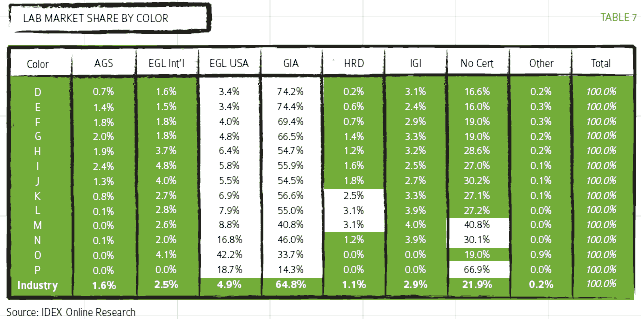 |
- Take a look at the EGL USA column and compare it to the GIA column. They are inversely proportionate. In other words, GIA has a disproportionate market share among the more colorless diamonds (D, E, F), while EGL USA has a disproportionate market share among diamonds with more color (K, L, M, N, O, P). At the P color level, EGL USA grades 18.7 percent of all diamonds P color while GIA grades only 14.3 percent of P color diamonds. Based on predictive models, we would have expected the GIA lab to grade roughly two-thirds (more or less) of all M, N, O and P color diamonds, so its lack of market share in those colors is notable.
- The HRD lab grades a large number of K, L and M color diamonds.
- Diamonds with more color are likely to have no certificate. A disproportionate number of diamonds M, N and P in color have no certificates. Strangely, O color diamonds are much more likely to have a certificate, and there is roughly a one-in-two chance that it is an EGL USA certificate.
The Labs: Grading Analysis By Clarity Of Diamond
For most consumers, diamond clarity is a bit of a mystery. While virtually all diamonds contain naturally occurring internal flaws – called Inclusions – most shoppers don’t know what to look for when a jeweler talks about diamond clarity.
The size, nature, location and number of inclusions determine a diamond’s clarity grade and its ultimate value. Only an ideal cut diamond typically has enough sparkle to mask otherwise noticeable inclusions. Most grading scales run from FL-IF, VVS1-VVS2, VS1-VS2, SI1-SI2 and finally I1-I2. However, among the diamonds in our sample, we found both SI3 and I3 diamonds. According to some industry insiders, an SI3 diamond is an I1 diamond with a public relations agent, and an I3 diamond should be sold for industrial use. But not everyone agrees with this assessment. Apparently, there is a large quality gap between an SI2 and an I1 diamond; thus, some argue, the SI3 grade is justified. Nevertheless, we analyzed all diamonds by all grades of clarity and the labs that graded them. We did, however, mostly ignore data on SI3 and I3 diamonds.
Further, there were too few FL (flawless) diamonds in our sample for us to draw any statistically significant conclusions, so we have excluded them.
Lab certificates by clarity
Table 8 summarizes the mix of diamonds by clarity that a particular lab grades. It should be read downward. For example, 22.4 percent of the certificates that the AGS lab issues are for VS2 diamonds.
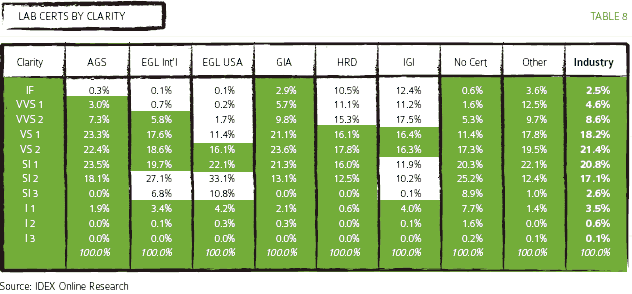 |
- Despite being the issuer of choice for ideal cut diamonds, the AGS lab grades very few internally f lawless (IF) diamonds. Most of their diamonds are in the VS1 to SI1 range, perhaps because the ideal cut can obscure flaws.
- Both the EGL International and EGL USA labs tend to issue a disproportionate number of certificates for lower clarity diamonds; they also tend to issue fewer certificates for diamonds in the IF, VVS1 and VVS2 range.
- The HRD lab tends to issue a disproportionate number of certificates for high-clarity diamonds.
- The IGI lab tends to issue more certificates for high-clarity diamonds and fewer certificates for diamonds with more inclusions.
Market share of each lab by clarity
Table 9 summarizes market share by lab by clarity for diamonds. It should be read across. For example, GIA grades 75 percent of all IF clarity stones, while HRD grades only 4.7 percent of all IF clarity diamonds.
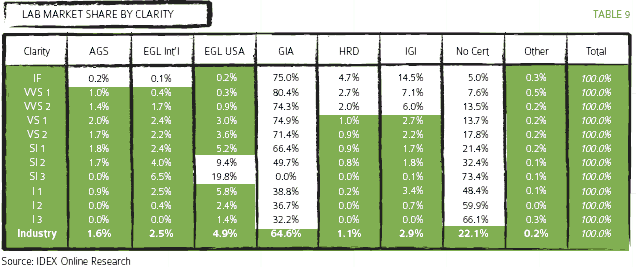 |
- Neither AGS nor EGL International labs grade many IF clarity diamonds.
- The EGL USA lab grades a disproportionate number of SI2 and SI3 diamonds.
- The GIA column indicates that this lab grades most of the higher clarity diamonds and fewer of the lower clarity diamonds.
- The higher the clarity of the diamond, the more likely it is to have a certificate. Diamonds with less clarity – grades SI3 and below – are more likely to have no certificate.
The Labs: Grading Analysis By Make (Cut Grade) Of Diamond
The make of a diamond Is often called the fifth “c” – for “cut grade.” The make grading process tells us just how good the diamond cut really is. The make of a diamond is probably the most important indicator of the “wow” effect of a stone.
Determining a diamond’s make is a bit of a qualitative process. Further, most jewelers don’t talk about make when they describe a diamond to their customers. In fact, nearly half (43 percent) of all diamonds do not list their make on the certificate as an overall grade but rather specific findings of polish, symmetry, proportions etc. Round diamonds that have the best make are called ideal cut; these diamonds have the most flash, fire, scintillation – the highest “wow” factor – and they typically fetch the highest per-carat price. Jewelers will always call attention to an ideal cut diamond, called “triple zero” by the AGS lab. That’s a diamond that reflects virtually all of the light entering the diamond back through the top of that diamond, creating maximum brilliance and sparkle. Otherwise, jewelers tend to neglect to talk about a diamond’s make (unless it is excellent and on the certificate) when selling a diamond to a customer.
Lab certificates by make
Table 10 summarizes the mix of diamonds by make that a particular lab grades. It should be read downward. For example, 79.6 percent of the certificates that the AGS lab issues are for ideal cut diamonds.
 |
- Almost four out of five certificates that the AGS lab issues are for ideal cut diamonds. That’s the domain of AGS.
- Only 11.9 percent of all diamonds graded by the AGS lab have no make listed on their certificates.
- Only 17.2 percent of all diamonds graded by the EGL International lab have no make.
- The EGL USA lab grades few diamonds as having an excellent make.
- The HRD lab grades few diamonds as having an excellent make.
- About two-thirds of the diamonds graded by the HRD lab have no make shown on their certificate.
- The IGI lab grades a disproportionate number of diamonds as having an excellent make.
Market share of each lab by make
Table 11 summarizes market share by lab by make for diamonds. It should be read across. For example, GIA grades 82.2 percent of all excellent make stones, while HRD grades virtually no excellent make diamonds.
 |
- The AGS lab issues more than two-thirds of all of the industry’s certificates for ideal make diamonds.
- The EGL USA lab issues a disproportionate number of certificates for good make diamonds.
- The GIA lab issues few certificates for ideal make diamonds, but has a disproportionate market share among grading labs of excellent make stones.
- The GIA lab issues most of the certificates for poor make diamonds.
- The IGI lab issues a disproportionate number of certificates for both ideal and excellent make diamonds.
Insurance companies say “certificate” is fifth “c” for diamonds
In theory, the same diamond should get nearly the same grade, no matter which lab grades the stone. But Idex online research has shown that some diamond grading labs are tougher than others. We wondered what happens when a customer – either a consumer or a jeweler – makes a claim to an insurance company for a lost diamond that has a certificate. Does the insurance company attempt to find a diamond with the same physical characteristics? Or do insurance companies take into account the grading differences in lab certificates?
We asked one of the most prestigious insurance companies (name withheld to protect their reputation) how they handle lost certified diamonds. Officials at the insurance company said it was clear that some labs graded much more strictly than other labs. Thus, this insurance company seeks to find a replacement diamond that not only matches the physical characteristics, but also has a certificate from the same grading lab as the lost diamond. Therefore, the industry’s insurance companies have made “certificate” the fifth “c” of diamond grading.
